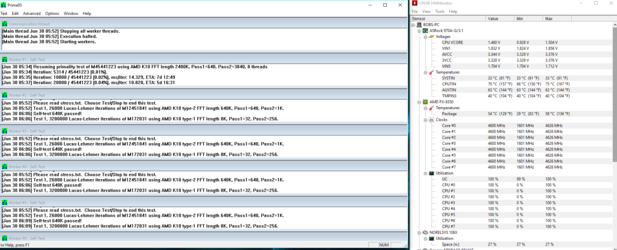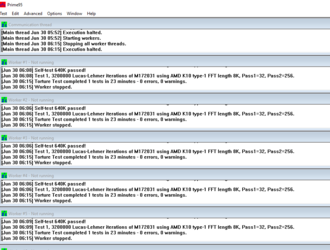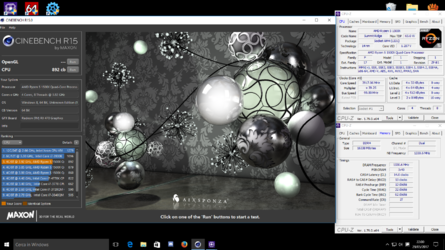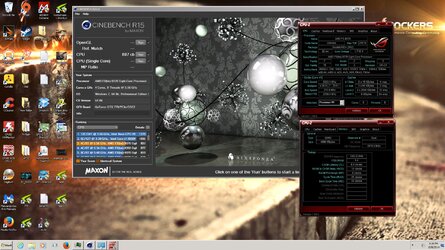I have an AMD FX-8350, ASRock 970A G/3.1 motherboard, 16MB Corsair DDR3 2400 RAM and a Corsair Hydro H100i V2 cooler in a full tower gaming case with a dual fan 700 watt PSU w/1 rear fan, 20 top fans, 3 front fans and a dual fan blower, MSI Radeon RX 560 AERO ITX 4G OC, 4GB, 128-Bit, GDDR5, DX12, PCIe Graphics Card.
The motherboard has UEFI which I have upgraded the BIOS to the latest. The configuration in UEFI is: I have put a ? where I am not sure if it’s correct, Bold is just description.
OC Mode = CPU OC Mode
Load Optimized CPU OC setting=15%
4600MHz
CPU Configuration
CPU Frequency=230 ?
PCIE Frequency=100 ?
Spread Spectrum=Disabled
CPU Active Core Control= All Cores
AMD Turbo Core Technology=Disabled
Current APM Status
AMD Application Power Management=Disabled
NB Maximum Frequency=6200MHz
Processor Maximum Frequency=6300MHz
NB Maximum Frequency=6200MHz
Processor Maximum Voltage=1.5500V
CPU Voltage= 1.4500V
NB Frequency Multiplier=X10% ? 2400MHz (if I go above that the system will not boot)
CPU NB Voltage=1.2500V
HT Bus Speed=Auto
HT Bus Width=16bit
DRAM Timing Configuration
Load Profile Setting=Auto
DRAM Frequency=DDR3-2239 ? (CMOS wants to set it to DDR 930 don’t know why)
DRAM Timing Control=Auto
Power Down Enable=Disabled
Bank Interleaving=Auto
Channel Interleaving=Auto
Voltage Configuration
DRAM Voltage=1.600V
CPU Voltage Offset=+50mV
NB Voltage 1.150V-Auto
PPU VDDA Voltage 2.56V=Auto
PIIE VDDA Voltage 1.81V=Auto
SB Voltage 1.10V=Auto
Cool and Quiet=Disabled
(The rest is default except for)
Aggressive Link Power Management=Enabled ?
Dard Disk S.M.A.R.T.=Dissabled
SATA 0 is an Intel SSD 600GB HD
I’m sorry this is so long but I figured whoever can help might need it. I’ve been running this configuration for 1 ½ weeks with no problem system is stable under 2 hours torture test. Last night I changed the CPU OC setting to 20%, the CPU Frequency to 240 but I had to keep the NB Frequency Multiplier at X10% or the system would not boot. It ran all day yesterday at blazing speed with no problem the CPU temperature went down each time I overclocked it higher again, don’t know why. Today I turned on the system and Windows 10 64bit would crash before booting with a blue screen and I had to dial it back down to 4.6GHz. What am I missing if anything or is it just the motherboard or whatever? Thanks.
The motherboard has UEFI which I have upgraded the BIOS to the latest. The configuration in UEFI is: I have put a ? where I am not sure if it’s correct, Bold is just description.
OC Mode = CPU OC Mode
Load Optimized CPU OC setting=15%
4600MHz
CPU Configuration
CPU Frequency=230 ?
PCIE Frequency=100 ?
Spread Spectrum=Disabled
CPU Active Core Control= All Cores
AMD Turbo Core Technology=Disabled
Current APM Status
AMD Application Power Management=Disabled
NB Maximum Frequency=6200MHz
Processor Maximum Frequency=6300MHz
NB Maximum Frequency=6200MHz
Processor Maximum Voltage=1.5500V
CPU Voltage= 1.4500V
NB Frequency Multiplier=X10% ? 2400MHz (if I go above that the system will not boot)
CPU NB Voltage=1.2500V
HT Bus Speed=Auto
HT Bus Width=16bit
DRAM Timing Configuration
Load Profile Setting=Auto
DRAM Frequency=DDR3-2239 ? (CMOS wants to set it to DDR 930 don’t know why)
DRAM Timing Control=Auto
Power Down Enable=Disabled
Bank Interleaving=Auto
Channel Interleaving=Auto
Voltage Configuration
DRAM Voltage=1.600V
CPU Voltage Offset=+50mV
NB Voltage 1.150V-Auto
PPU VDDA Voltage 2.56V=Auto
PIIE VDDA Voltage 1.81V=Auto
SB Voltage 1.10V=Auto
Cool and Quiet=Disabled
(The rest is default except for)
Aggressive Link Power Management=Enabled ?
Dard Disk S.M.A.R.T.=Dissabled
SATA 0 is an Intel SSD 600GB HD
I’m sorry this is so long but I figured whoever can help might need it. I’ve been running this configuration for 1 ½ weeks with no problem system is stable under 2 hours torture test. Last night I changed the CPU OC setting to 20%, the CPU Frequency to 240 but I had to keep the NB Frequency Multiplier at X10% or the system would not boot. It ran all day yesterday at blazing speed with no problem the CPU temperature went down each time I overclocked it higher again, don’t know why. Today I turned on the system and Windows 10 64bit would crash before booting with a blue screen and I had to dial it back down to 4.6GHz. What am I missing if anything or is it just the motherboard or whatever? Thanks.




